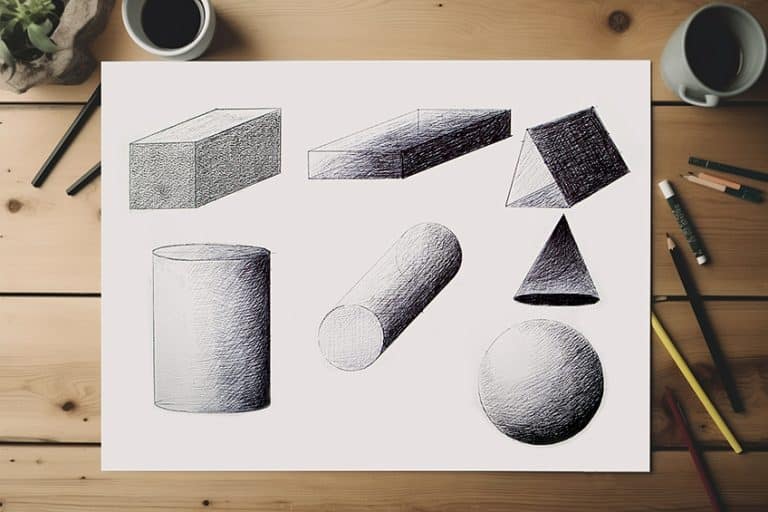Easy Patterns to Draw – 35 Pattern Ideas for Drawing
Learning which easy patterns to draw is a fun and useful exercise to practice your drawing skills as well as to learn a variety of new pattern design ideas that can be incorporated into your artwork. Patterns can be used in all sorts of ways, whether they are for abstract artworks or to be integrated into fabric designs for character drawing. The ideas for using pattern design ideas are endless, and in this tutorial, you will be provided with a few fun and simple pattern ideas that you can add to your drawing repertoire.
Table of Contents
- 1 An Easy Guide to Drawing Patterns
- 2 Easy Patterns to Draw
- 2.1 Preparation
- 2.2 Criss-Cross Pattern
- 2.3 Checkerboard Pattern
- 2.4 Triangle Checkerboard Pattern
- 2.5 Diagonal Stripes Pattern
- 2.6 Squares-in-Squares-Pattern
- 2.7 Diagonal Stripes Pattern
- 2.8 Bauhaus Pattern
- 2.9 Tree Trunk Pattern
- 2.10 Liquid Effect Pattern
- 2.11 Line Gradient Pattern
- 2.12 Wave Pattern
- 2.13 Cow Pattern
- 2.14 Asymmetrical Polka-Dots Pattern
- 2.15 Inverse Cow Pattern
- 2.16 Net Pattern
- 2.17 Squiggly Spiral Pattern
- 2.18 Tree Branch Pattern
- 2.19 Retro Squares
- 2.20 Overlapping Curves Pattern
- 2.21 Childish Scribble Pattern
- 2.22 Zig-Zagging Segments Pattern
- 2.23 Tiger Print Pattern
- 2.24 Cursive “E” Pattern
- 2.25 Cell Pattern
- 2.26 Retro Olive Pattern
- 2.27 Scales Pattern
- 2.28 Spikey Scales Pattern
- 2.29 Smooth Tree Branch Pattern
- 2.30 Flowing Fabric Pattern
- 2.31 Punched Holes Pattern
- 2.32 Retro Square Pattern
- 2.33 Criss-Cross Tiles Pattern
- 2.34 Skyline Pattern
- 2.35 Abstract Bats Pattern
- 2.36 Curved Polka-Dot Pattern
- 3 Tips to Remember
- 4 Frequently Asked Questions
An Easy Guide to Drawing Patterns
Learning how to draw patterns is a simple task that can easily be followed and adapted into your own creative practice. Pattern ideas for drawing can be a great way to mentally experiment with potential surface and textural ideas that can be integrated into your drawings. In this basic pattern drawing tutorial, we will be exploring a variety of different patterns that can be drawn by understanding a basic descriptive process.
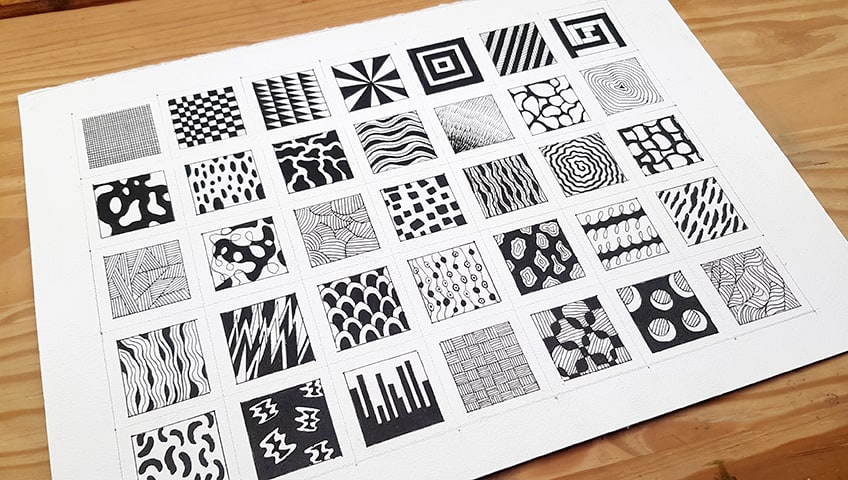
Necessary Materials
This tutorial explores simple easy patterns to draw that can be done with any drawing tool; however, to keep it simple we will be working with some basic pens. We will also want to make sure we have a ruler and some decent paper for the drawing process. Once we have all the necessary materials, we can begin to prepare ourselves mentally for the drawing process by finding a space where we can relax and engage with the tutorial.
- Ballpoint Pen
- Micron Pens
- Ruler
- Pencil
- Paper
Easy Patterns to Draw
In this tutorial, we will be going through a series of 35 simple, easy-to-draw patterns, that can be done with a pen and marker. We will have a brief description of each, allowing us to understand the basic formation process of each basic pattern. There is a combination of various different pattern styles that take only a minute or two to draw. That being said, let’s go through a variety of easy basic patterns to draw.
Preparation
Let’s start by creating a grid with 35 blocks in total. We can do this by dividing our page into 5-cm increments, and we should have a 7 x 5 grid with a total of 35 blocks.
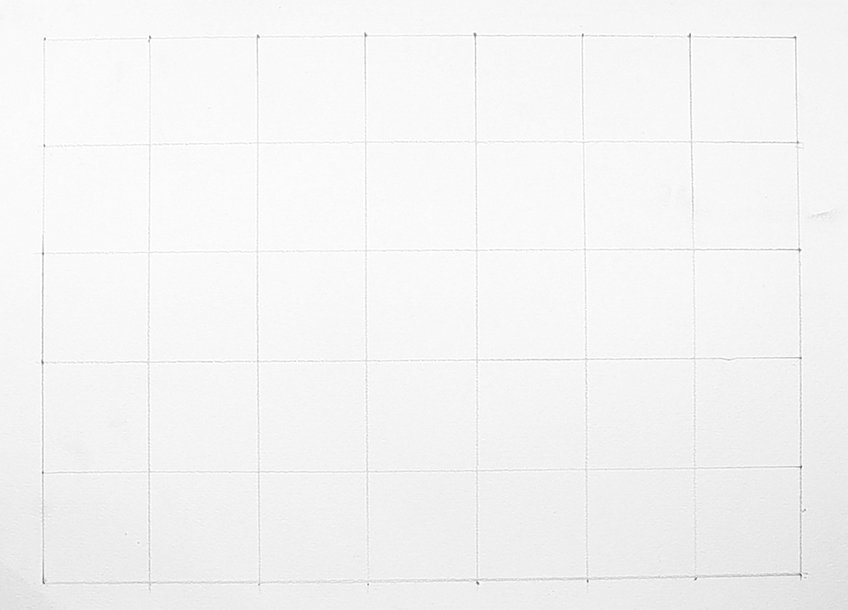
Once we have our grid prepared, we can begin to draw a smaller square within each block. This will give us parameters in which we can draw different patterns, we can keep a 1-cm space along the inside of each block.

Criss-Cross Pattern
The first pattern is a classically styled pattern and is very versatile. This pattern can easily be drawn with a ruler and pen. Simply draw a set of horizontal lines overlapping a set of vertical lines. This can be drawn thin or thick and the result often has a beautiful woven textural effect.
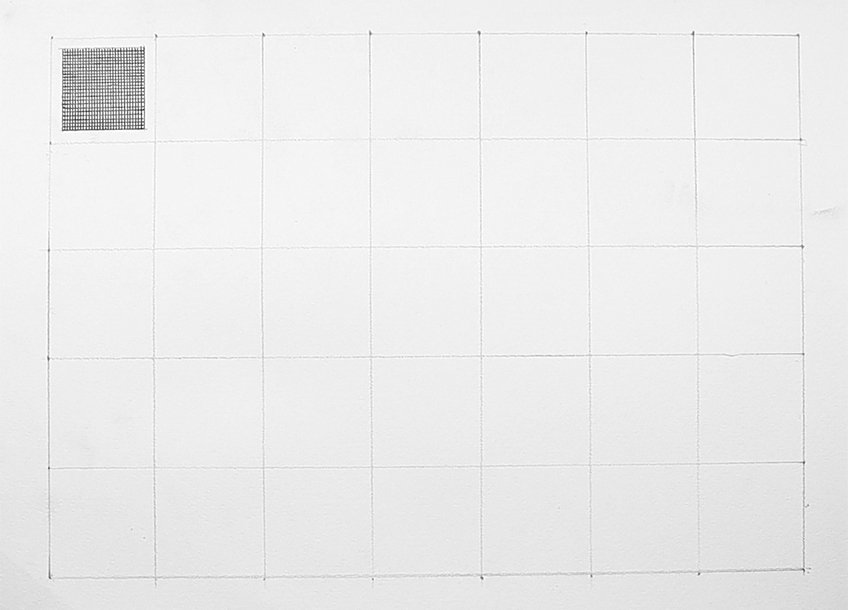
Checkerboard Pattern
Another classic pattern that can easily be utilized within an artwork is the checkerboard pattern. This simple pattern can be drawn by creating a set of evenly spaced blocks of vertical and horizontal lines. You then can simply color in every second square to create the checkered effect.
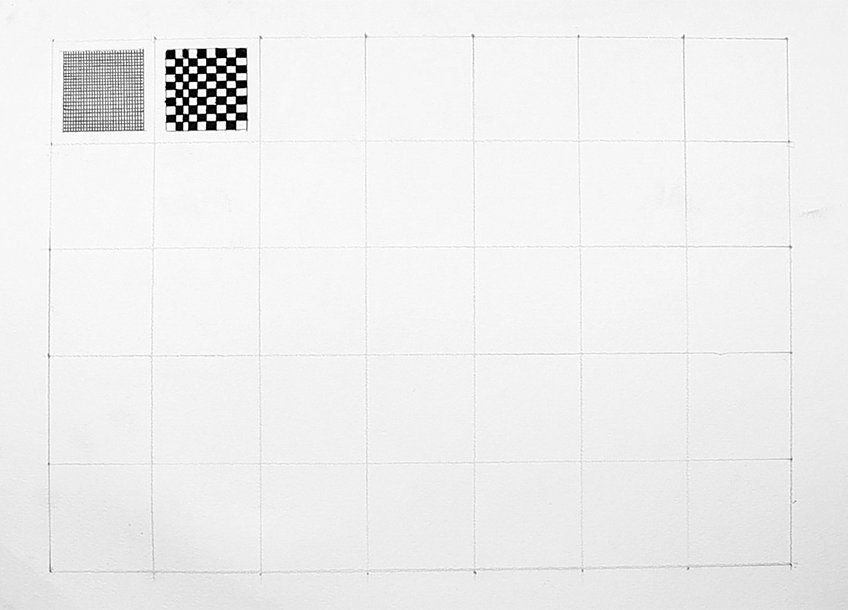
Triangle Checkerboard Pattern
This is a variation of the same checkerboard but with a twist. This time, as you create a grid of evenly sized squares, you want to draw identical diagonal lines within each square.
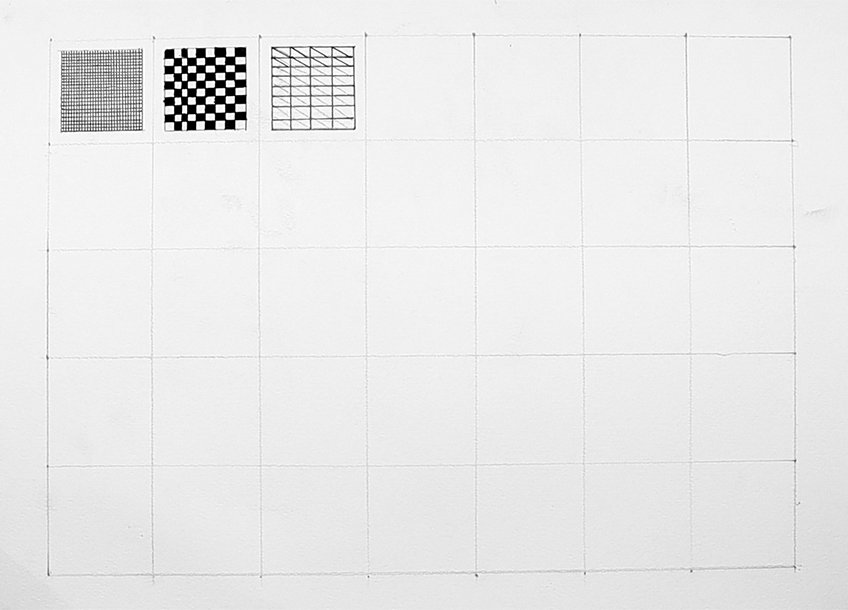
From there, you can simply color on the same side of each diagonal line within each square. This will create an interesting triangular checkerboard aesthetic.
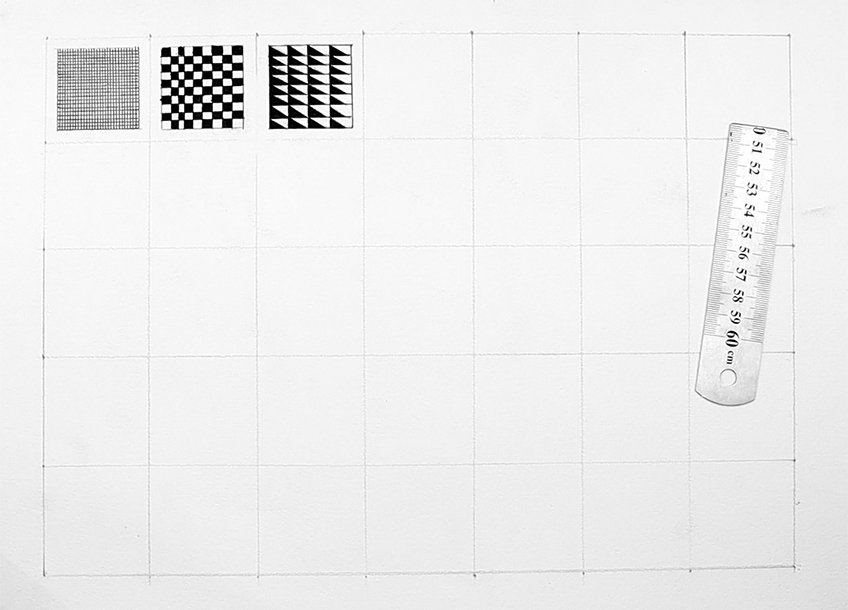
Diagonal Stripes Pattern
The next one is really simple. This simple pattern can be drawn by making two diagonal lines that start from the corners of the square and intersect in the middle of the square. From there, you can add more diagonal lines as you wish. You can also leave the pattern blank or fill it in.

Squares-in-Squares-Pattern
This simple pattern can be drawn by drawing a smaller square each time within the last square. You can also color in every second square to create an illusion effect within the pattern.
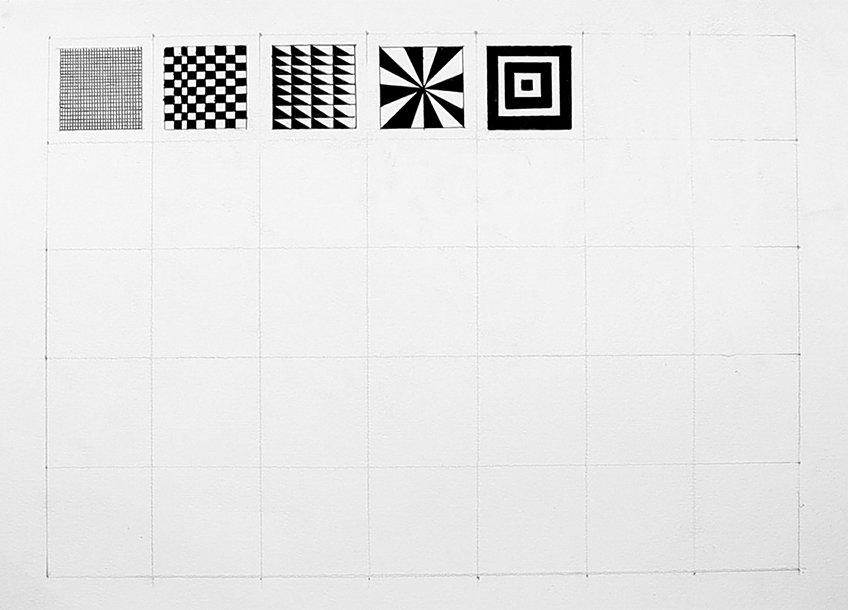
Diagonal Stripes Pattern
This pattern can be drawn with your ruler and pen, by creating a set of evenly spaced diagonal lines within the square. You then can color in every second stripe.

You can also be creative by adding smaller lines within the open blank stripes in between every black stripe.
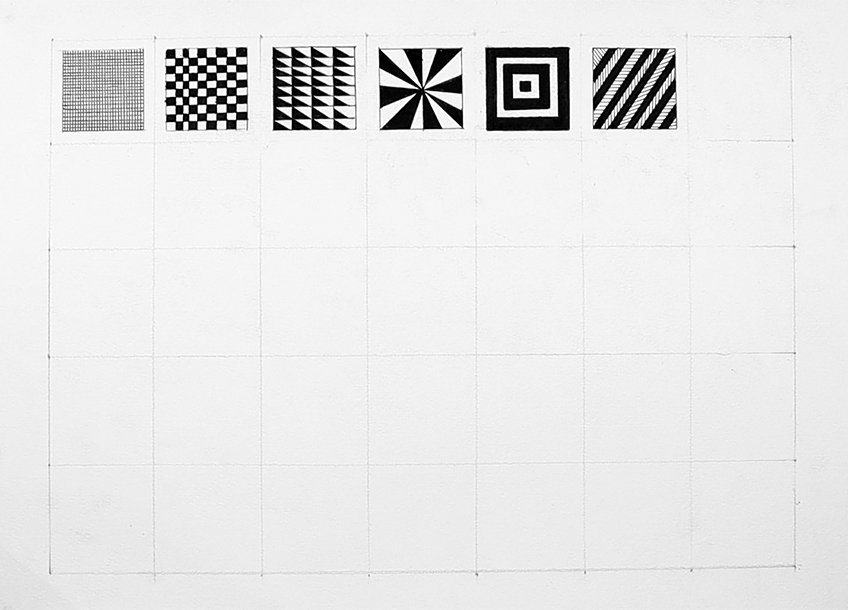
Bauhaus Pattern
In a similar process to the previous pattern, we will draw smaller squares each time within the last square. However, this time, we can draw lines within a clockwise motion, allowing for the squares to unfold as you draw a parallel line along the border of the last square.
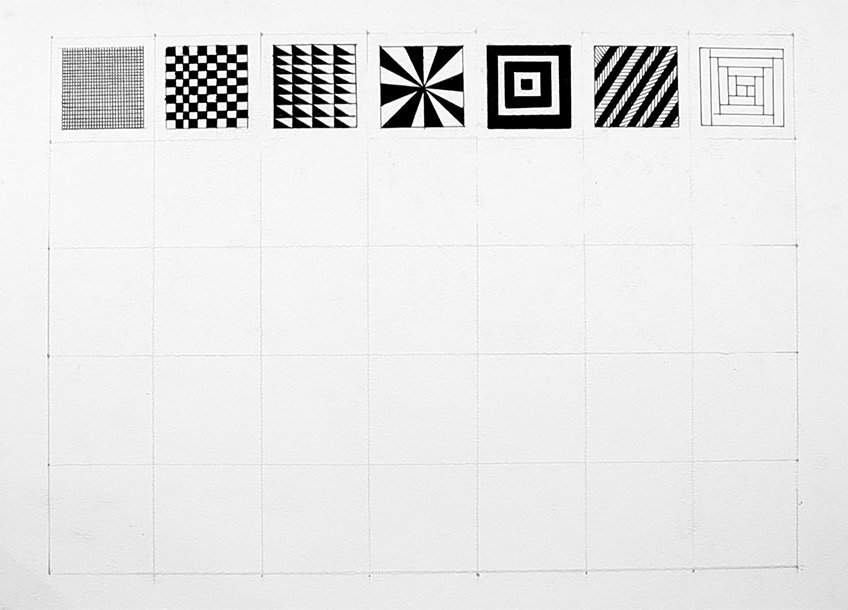
This pattern creates a geometric-like spiral that can often be visually tied to the Bauhaus aesthetic, making it a great pattern for abstract pattern design ideas.
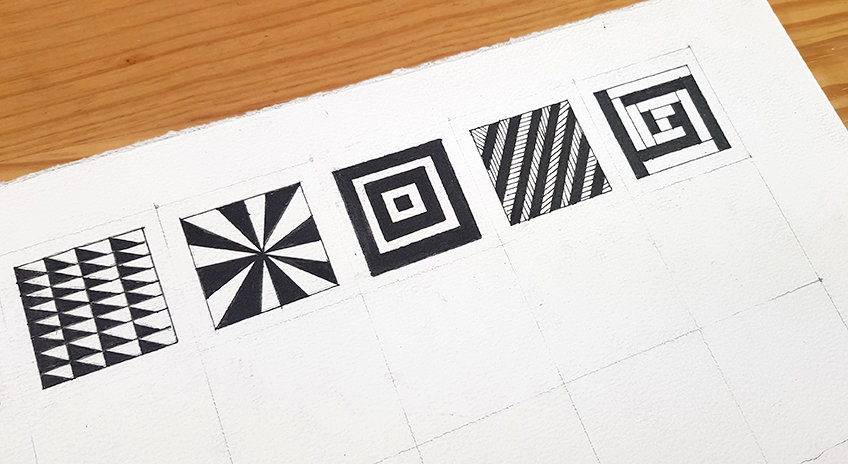
Tree Trunk Pattern
Nature provides us with a variety of easy patterns to draw and this one has an organic feel and is very simple to draw. We can begin by making a small irregular shape in the middle of the square. From there, we simply enlarge the shape by drawing irregular parallel lines around the irregular shape.

Liquid Effect Pattern
The next easy pattern to draw has a water-like effect and is really simple to draw. We begin by drawing irregularly shaped lines, allowing them to intersect sporadically.
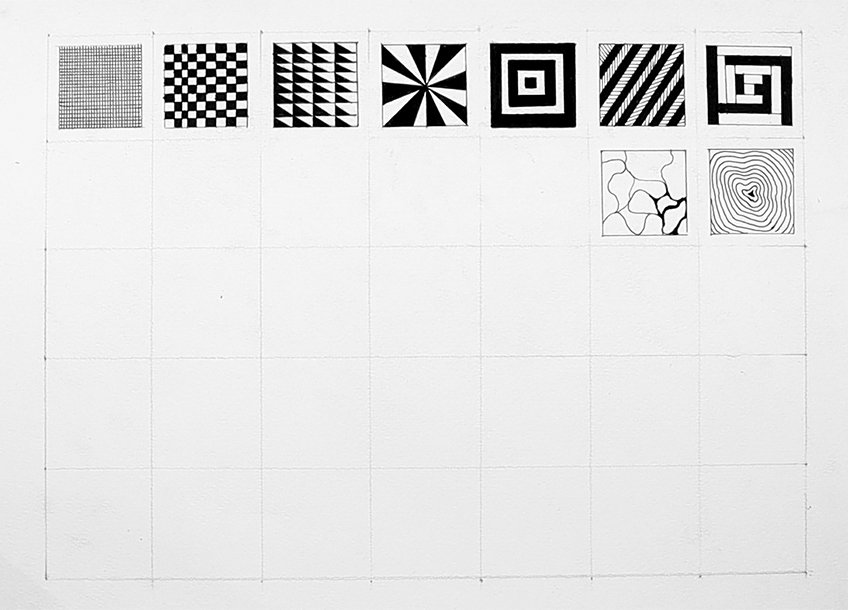
From there, we can draw thinner and thicker marks over various areas of the lines. Drawing thicker marks near the intersecting areas will create a liquid webbing effect.

Line Gradient Pattern
This simple pattern is a great way to create a gradient between lighter and darker marks. We draw this pattern by starting with a dense group of lines in one corner of the block. We then slowly lessen the lines in rows until the other end of the block, resulting in a seamless line gradient.
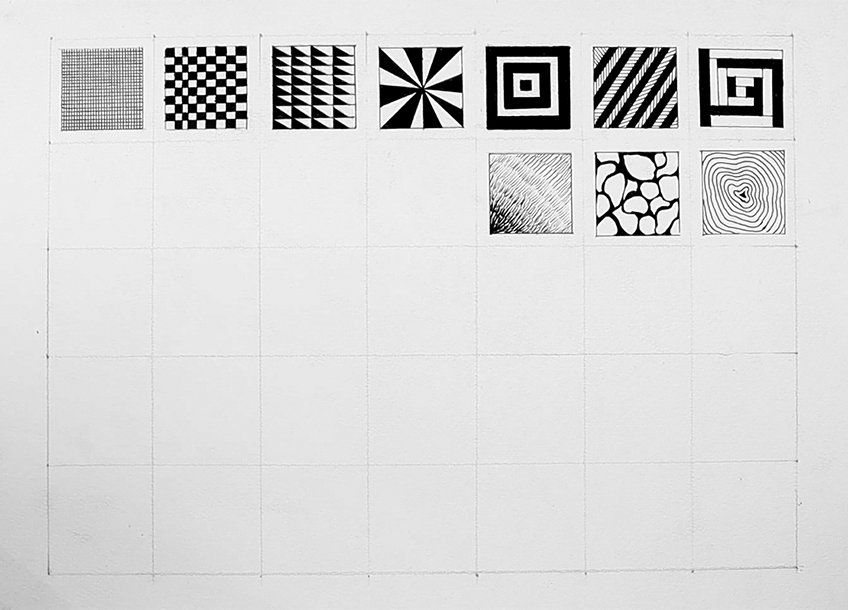
Wave Pattern
The next pattern is another water-styled pattern. This pattern is really simple and easy to draw. We create this pattern by drawing a set of curved horizontal lines that oscillate up and down.

We can thicken areas in each line that curves upward and downward. We can also add thinner lines in between these thicker wave patterns, to give the pattern more details and nuance.
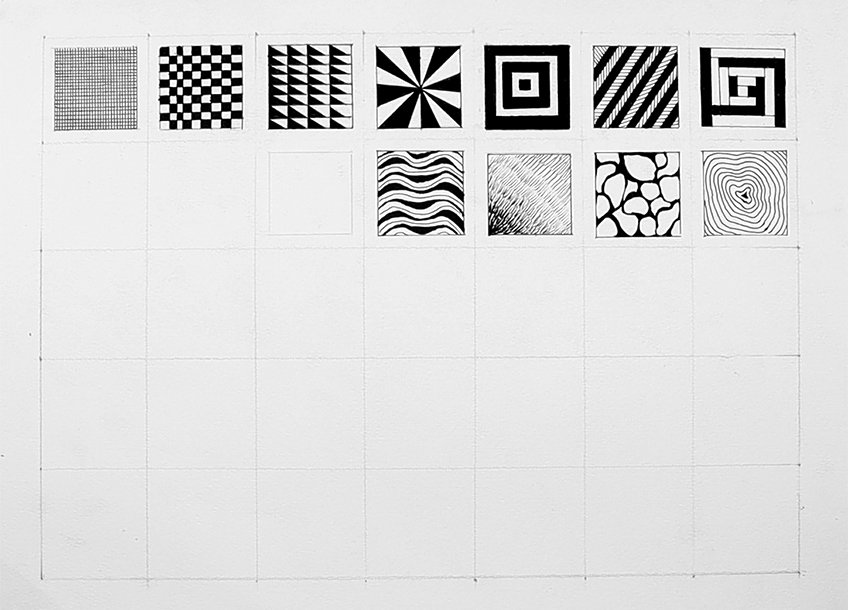
Cow Pattern
This next easy pattern to draw is inspired by the patterns found on the skin of cows. This can easily be drawn by creating various irregular shapes that form around one another. From there, you can simply fill in the patterns with a marker.
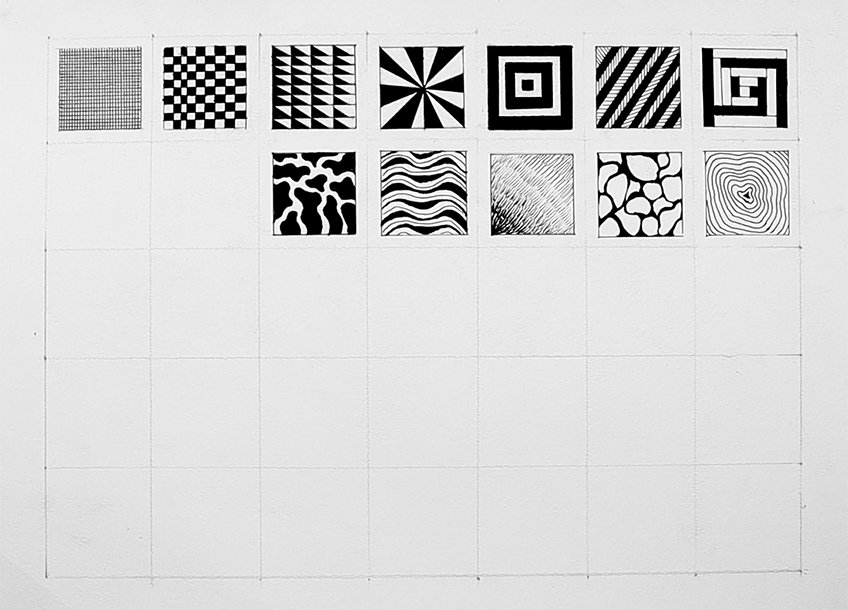
Asymmetrical Polka-Dots Pattern
The next pattern is another classic; however, what makes this pattern a little more unique than regular polka dots is that each dot varies in size and length.
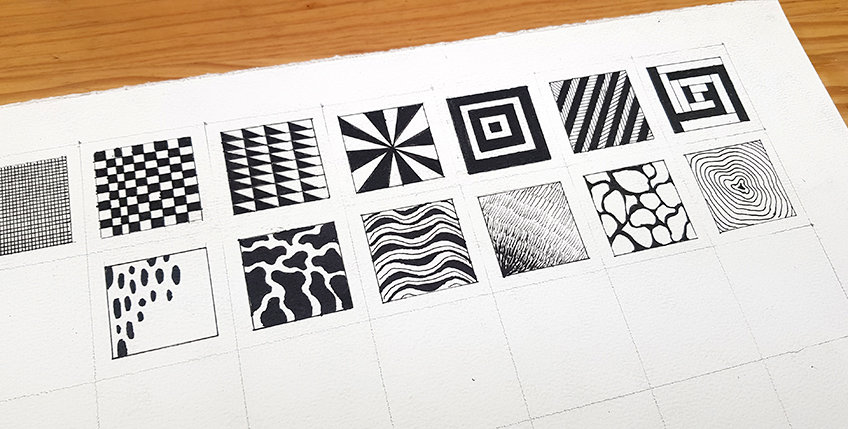
This pattern style of polka dots is really effective when you allow yourself to create variations of polka dot sizes. Some long, some short, some round or some thin – it’s really up to you.
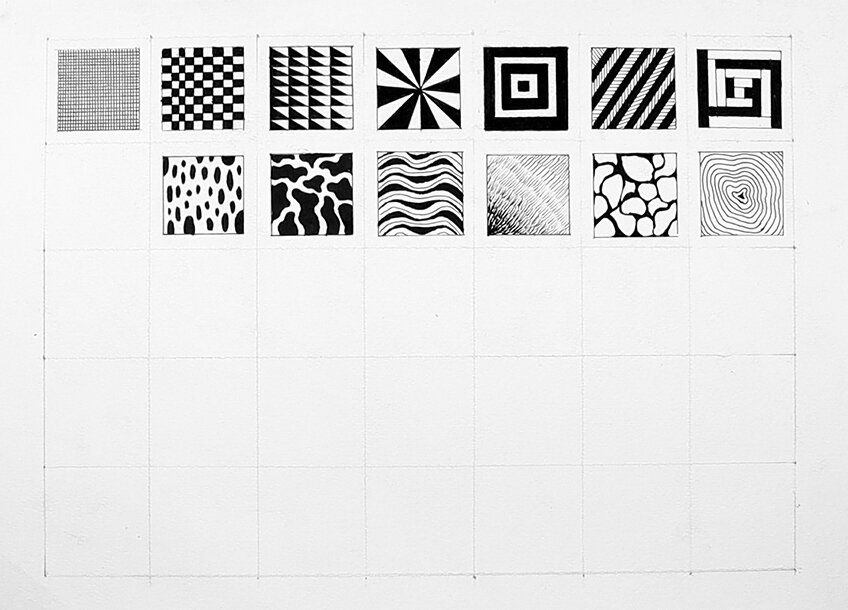
Inverse Cow Pattern
In this easy pattern to draw we will find that it is the same as the last cow pattern, except this time, it is the inverse. This means that we can create a set of irregular shapes and fill in the area around the patterns with a marker.
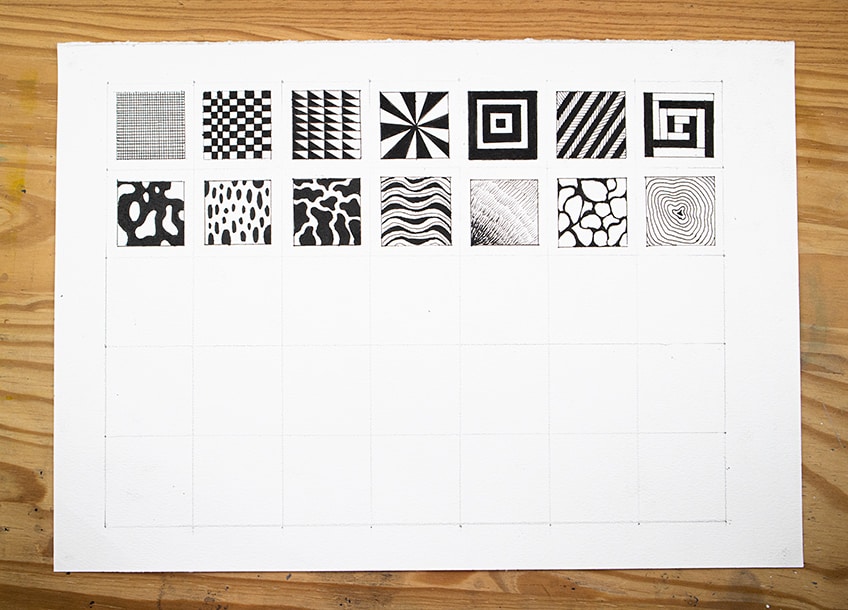
Net Pattern
The next pattern is a little strange and has an interesting abstract quality. We start by drawing a set of dots that run in vertical and horizontal rows.
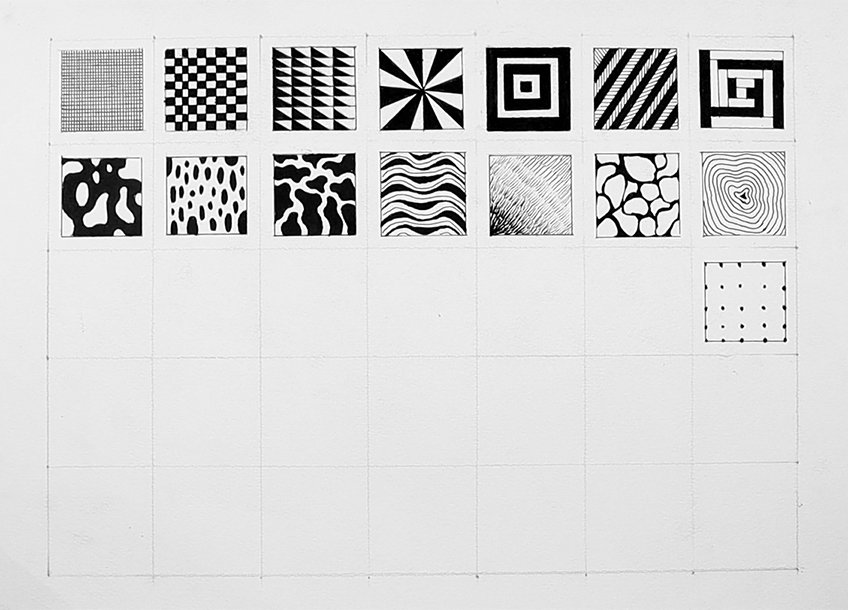
From there, we will connect the dots, but we will do so by curving the lines as if they were oscillating up and down in a horizontal fashion or side to side in a vertical fashion. We want to make sure the curved areas move away from each other as the vertical and horizontal lines intersect.

From there, we can embolden the lines in various areas as we like. It is nice to have thinner and thicker moments of lines within this net-like pattern.
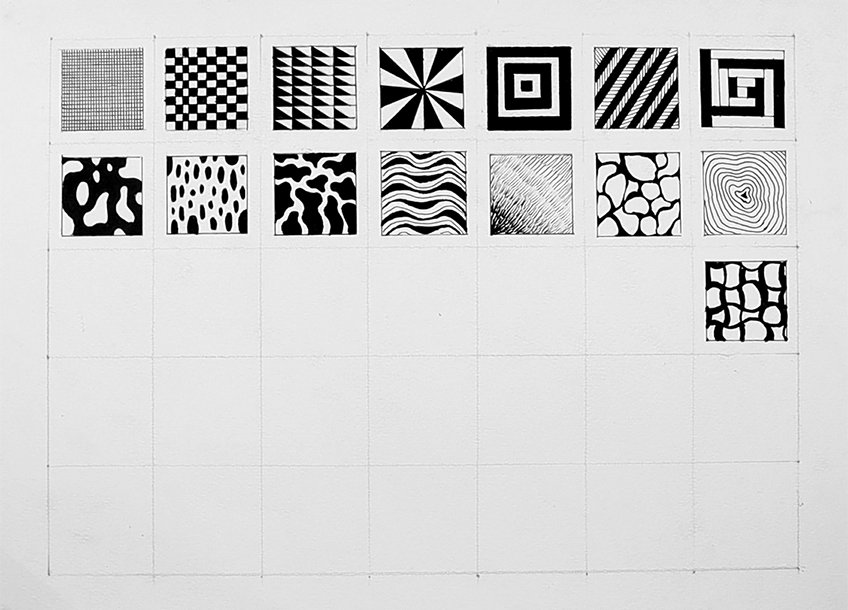
Squiggly Spiral Pattern
The squiggly spiral pattern is simple but really beautiful. This pattern can be drawn by starting with a squiggly spiraling shape, that slowly enlarges as you continue to fill the block.
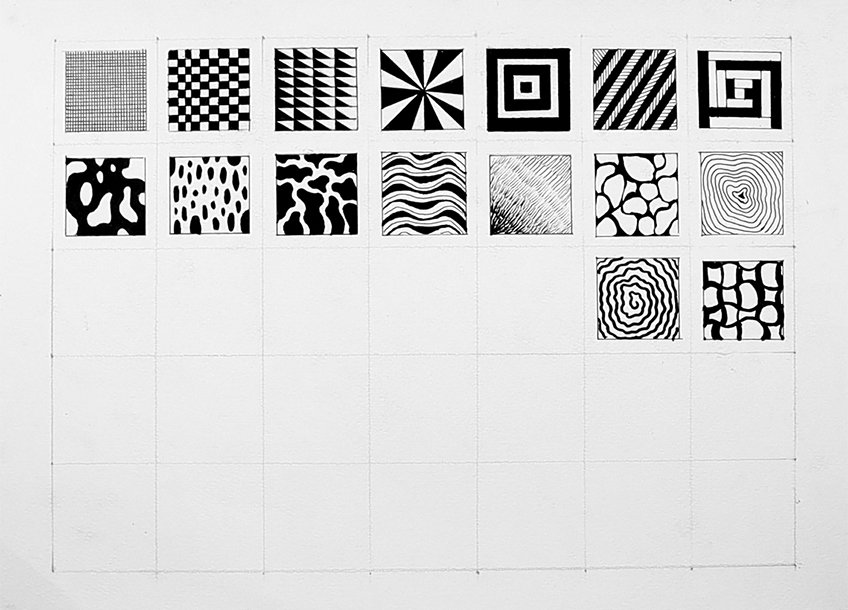
Tree Branch Pattern
Drawing inspiration from nature will always be an effective way of finding patterns. This pattern is inspired by the trunk of the tree. We draw this pattern by creating a set of vertical curved lines that run parallel with one another.
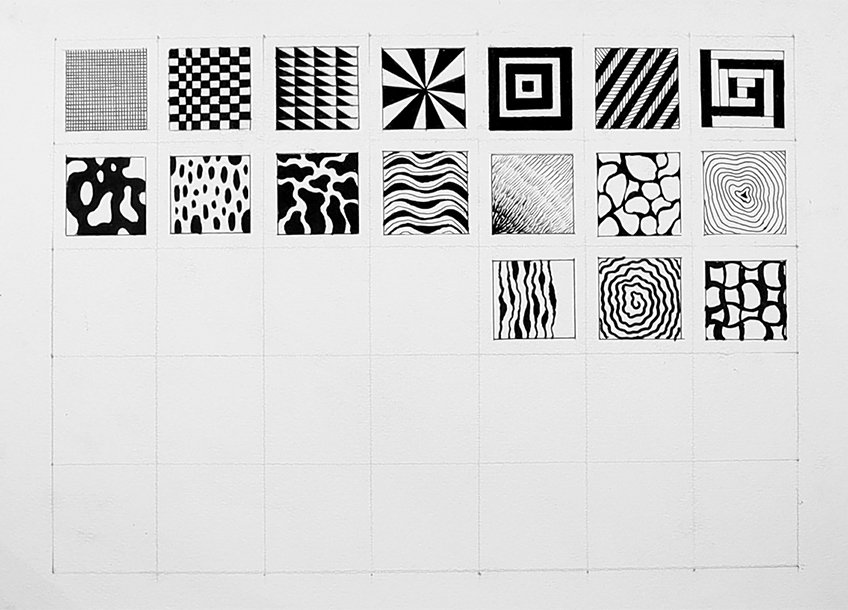
You want to keep the lines skew and squiggly with moments of thick areas in each line. You can also draw thin lines in between these thicker lines to create a more interesting aesthetic.
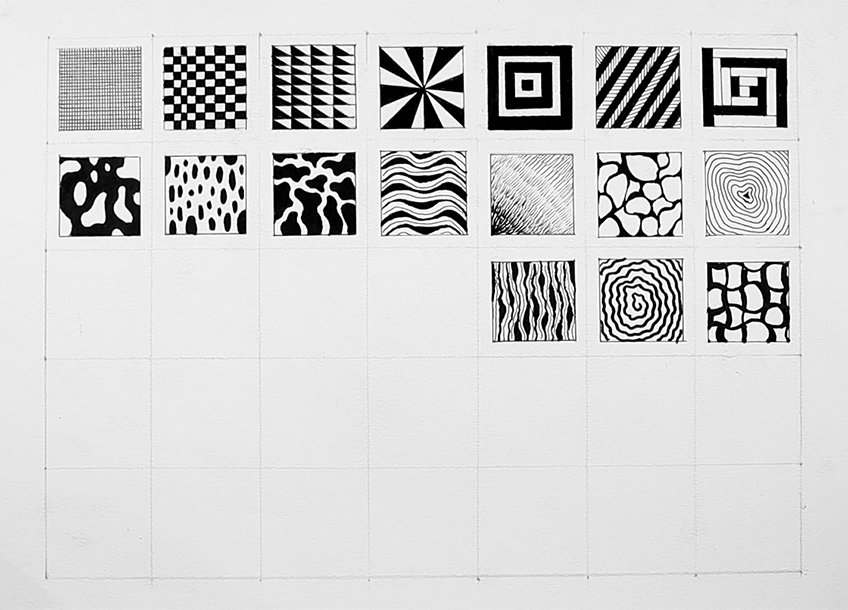
Retro Squares
This next pattern is super simple and can give off a very retro vibe, which can be great for period-styled drawing ideas. We draw this pattern by creating a set of irregular squares, that are imperfect and different in size.

Overlapping Curves Pattern
This pattern is quite an optical illusion and it is really simple to draw. You basically want to draw curved lines starting from one side of the block. Then, you build up a set of these curves going in various directions.
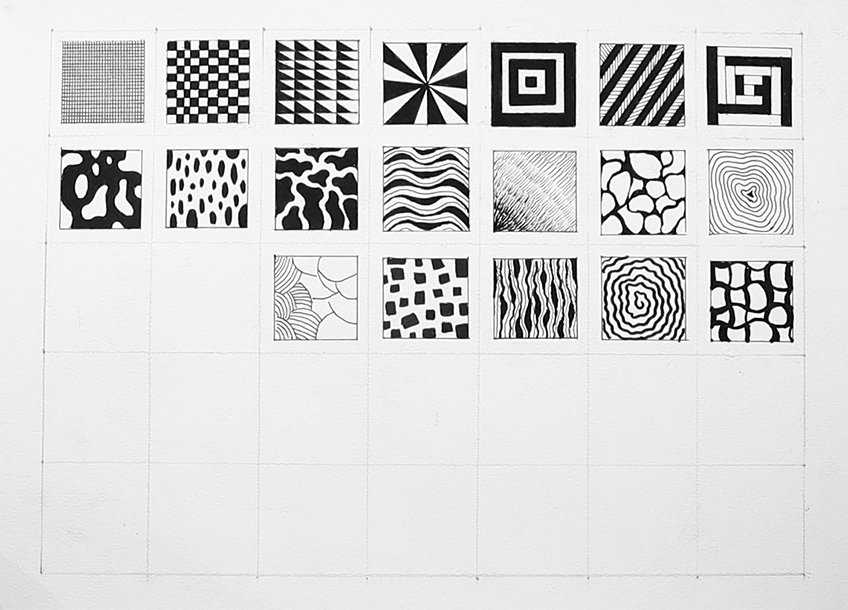
You then can fill in these curved shapes with parallel lines that run along the curved shape. This creates a unique stacking effect.
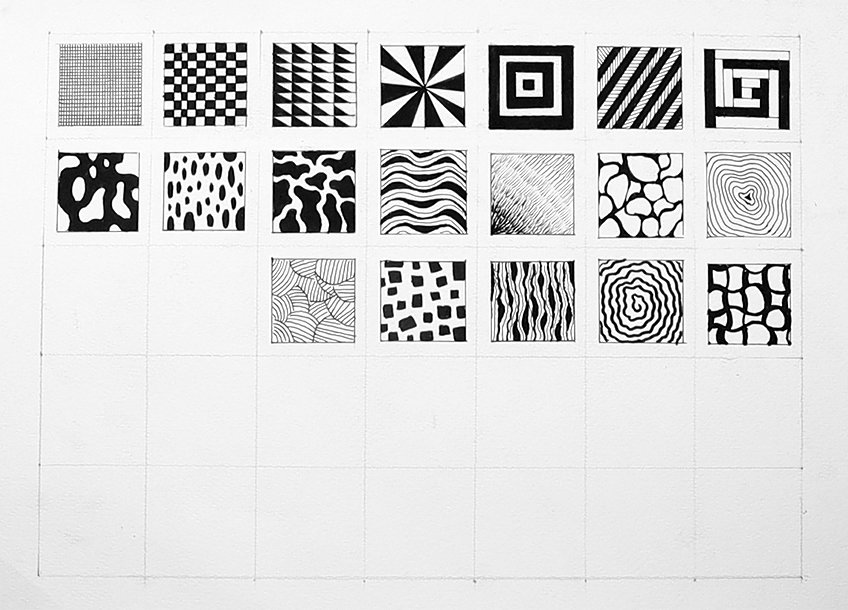
Childish Scribble Pattern
This is perhaps the most fun and freeing pattern to draw, and it’s rooted in most of our childhood drawing experiences. You simply allow yourself to scribble in various sporadic directions, allowing lines to intersect.
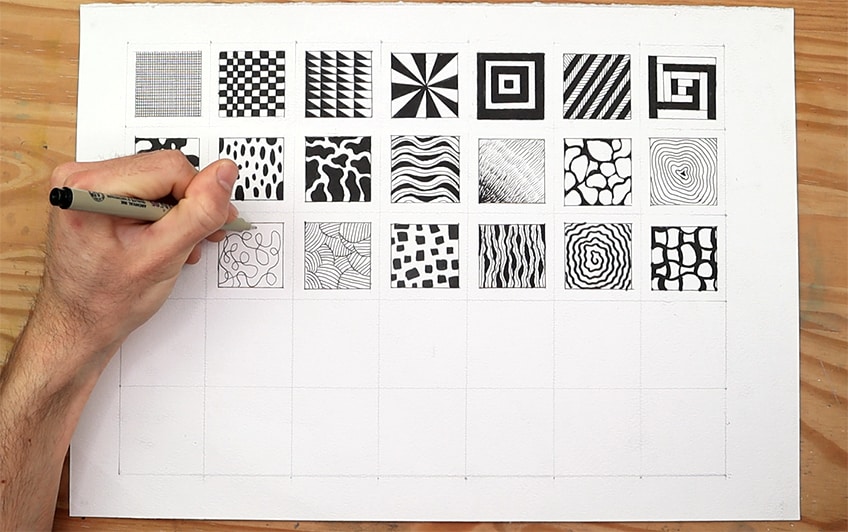
You then can simply fill in different areas within the scribble to create a strange and playful pattern quality. This can actually be a really beautiful print and addition to various artworks and pattern design ideas.
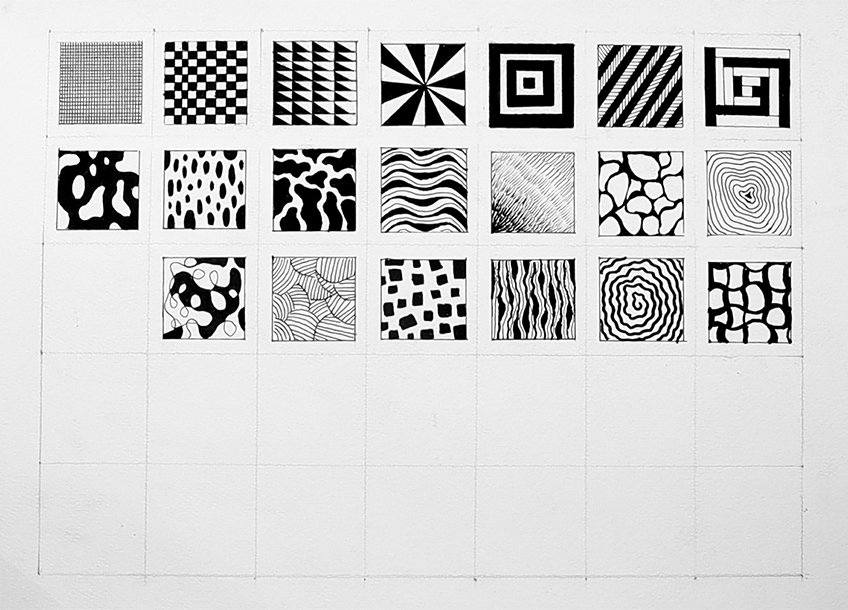
Zig-Zagging Segments Pattern
This next pattern has a really cool effect and is really simple to draw. you start by drawing segments with your ruler that move in different directions. From there, you start to fill in the segments with lines.

The trick with this pattern is to make the lines in each segment move in different directions. By doing this, you create this weird stacking-illusion-geometric effect.

Tiger Print Pattern
The next pattern is another classic-style pattern that often is used within the realms of fashion. We create this pattern style by simply drawing a set of elongated irregular shapes as if there were stretched-out polka dots.

Cursive “E” Pattern
This next pattern has a very elegant aesthetic and is simple to draw. We draw this pattern by creating horizontal rows of the cursive-styled letter “E” we want to make a row that is upright than a row that is upside down. From there, we can fill in every second row with color.
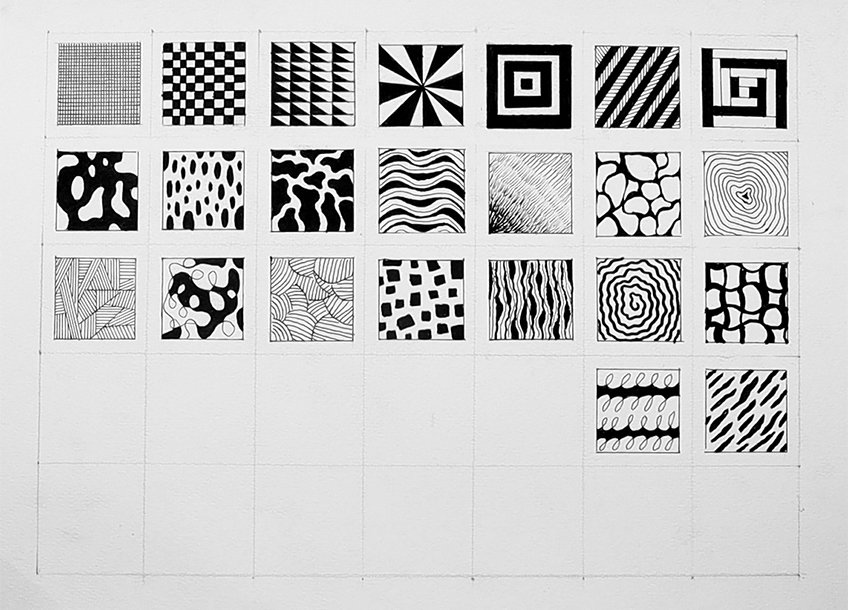
Cell Pattern
In many ways, there is a lot to nature and how it can inspire design, including the microscopic world. This cell pattern can be drawn by creating a set of randomly-shaped circular patterns. We can create a set of parallel lines within each one.
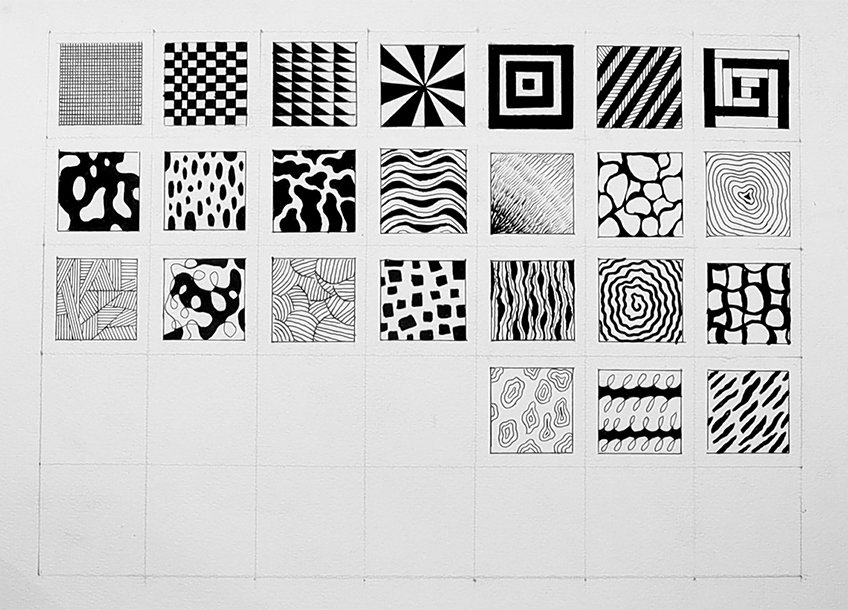
From there, we can simply fill in the space around these little irregular shapes to create contrast between the shape and the background.
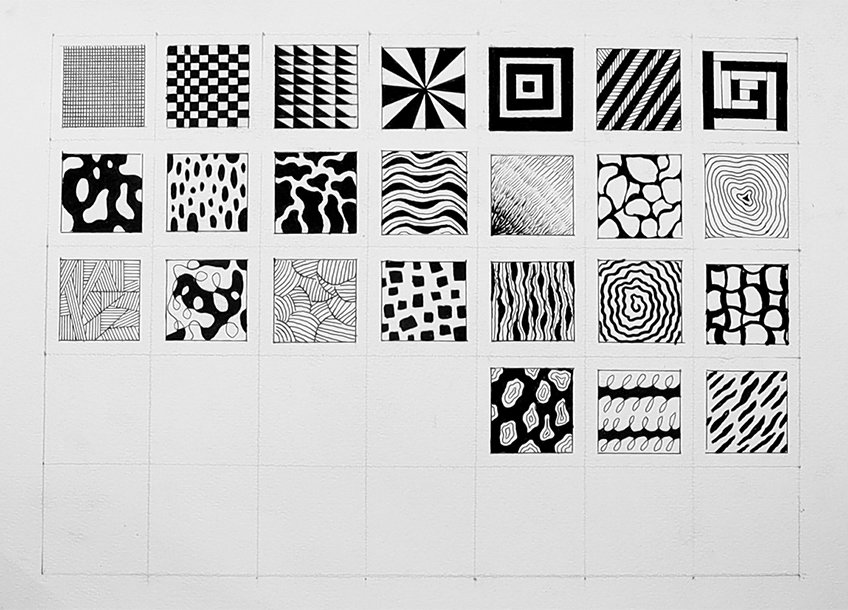
Retro Olive Pattern
This is another retro-inspired pattern, and it looks a lot like a string of olives. We draw this pattern with this idea in mind. We can start by creating a set of curved vertical lines that flow side to side. From there, we can simply draw olive shapes along each line.

We can also create separation and variety by also drawing in black dots along the lines. The olive shapes can be drawn as circles with a dot in the middle.
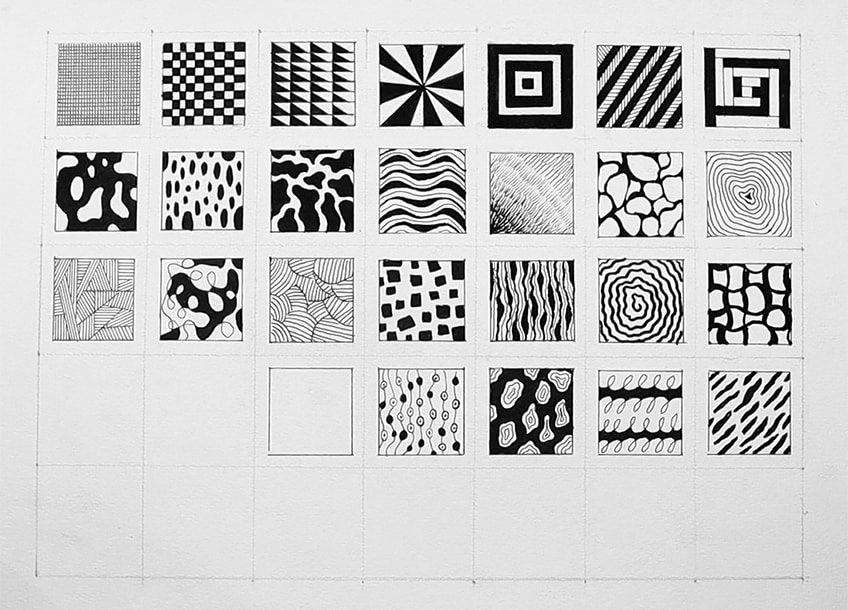
Scales Pattern
This pattern is inspired by scales that can be found on various animals. we start by drawing a row of arched shapes along the bottom of the block. We then keep stacking these shapes on top of one another in horizontal rows.
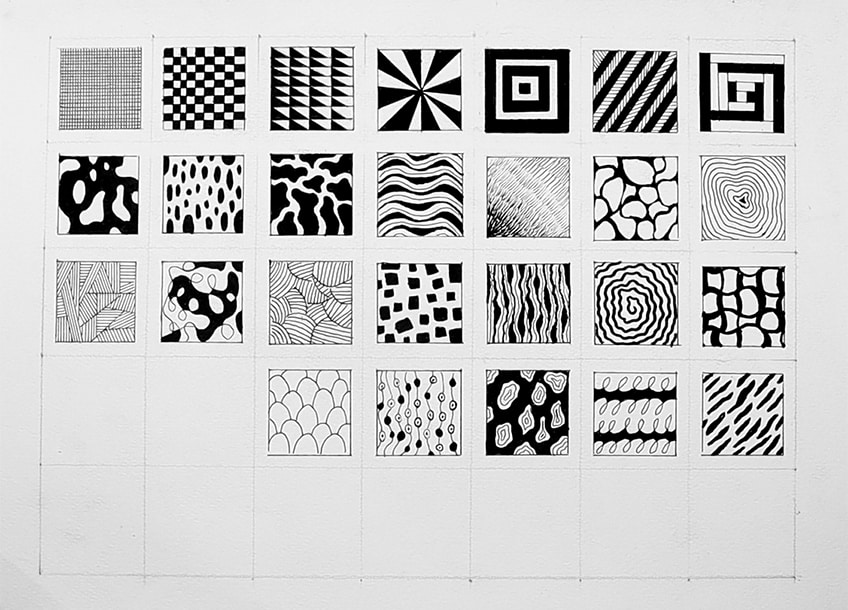
The idea is to always draw the next row of scales on top of the middle area between the bottom two scales. From there, we can add smaller arches within each scale.
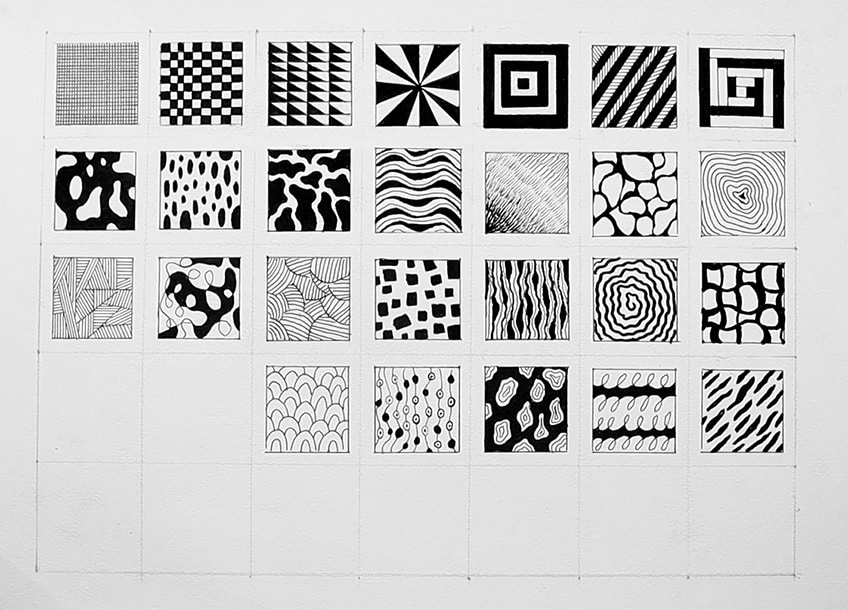
Then, lastly, we can fill in each smaller arch that exists within each scale to create a more enriched textural quality in the pattern.

Spikey Scales Pattern
This pattern follows the same process as the previous one. we simply create rows of spikes and keep stacking them on top of one another. From there, you can play around with how you color them in.

You can also create smaller spikes within the larger ones and then color in those smaller spikes to create a weird pattern style.
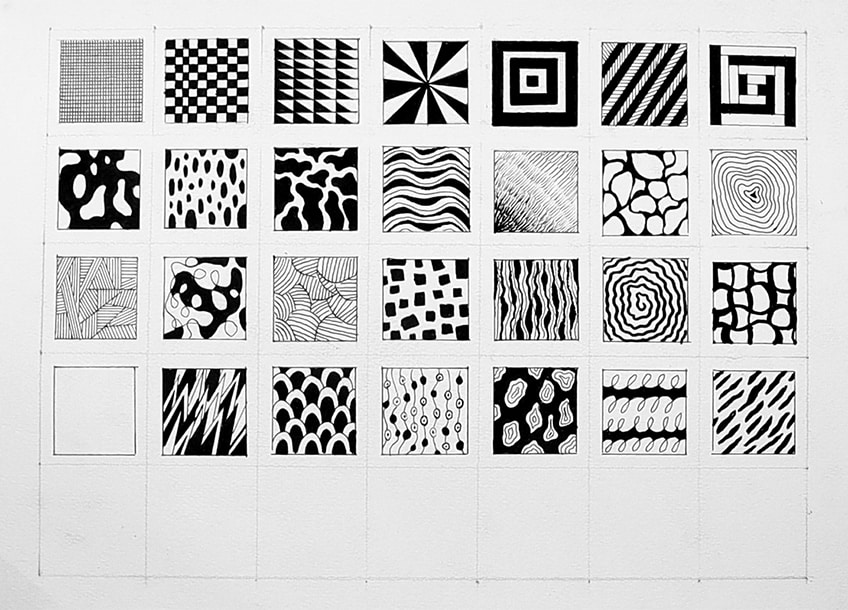
Smooth Tree Branch Pattern
This is another tree branch pattern design, however, this time, the lines are equal in width and thickness. as before, we can draw vertical curving lines with moments of thickened sections. However, we want to use a single pen width and keep the lines close together.

You can also allow the lines to have a little more curve, allowing them to arch and turn more. Keeping the lines parallel and the same thickness will create a smoother texture.
Flowing Fabric Pattern
This next pattern is a simple yet interesting one. We draw this pattern by creating a set of straight diagonal lines. We then draw curved lines in between those straight diagonal lines. We want to make sure that curves move in different directions between each diagonal straight line.

From there, we can add lines to each curve, creating a set of parallel lines that move with the flow of each curve. You make these lines move in opposite directions in each curved segment to create a flowing fabric effect.
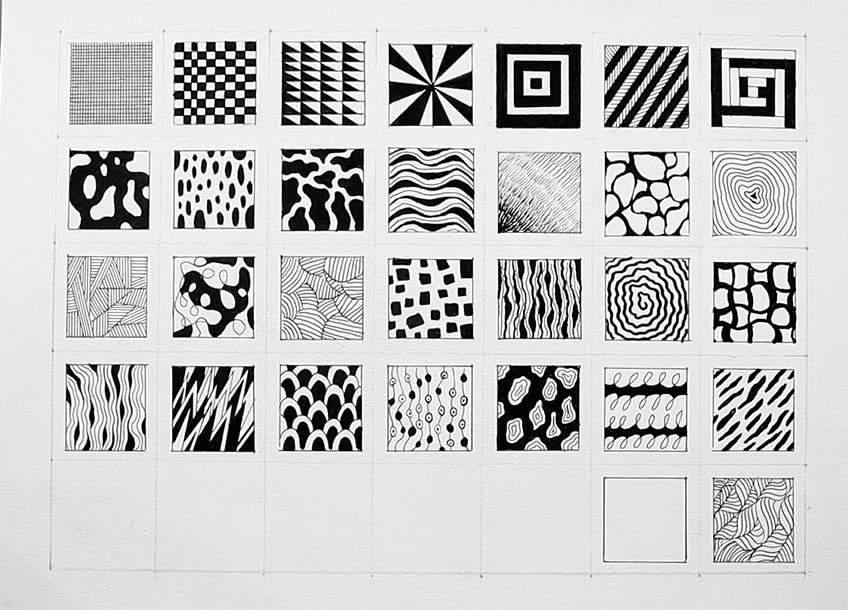
Punched Holes Pattern
This fun illusion-styled design is another easy-to-draw pattern. We start by drawing a bunch of circles, and then we can draw a little curve on one inner side of each circle to create a three-dimensional effect. We can then add lines into the larger inner space in the circle.
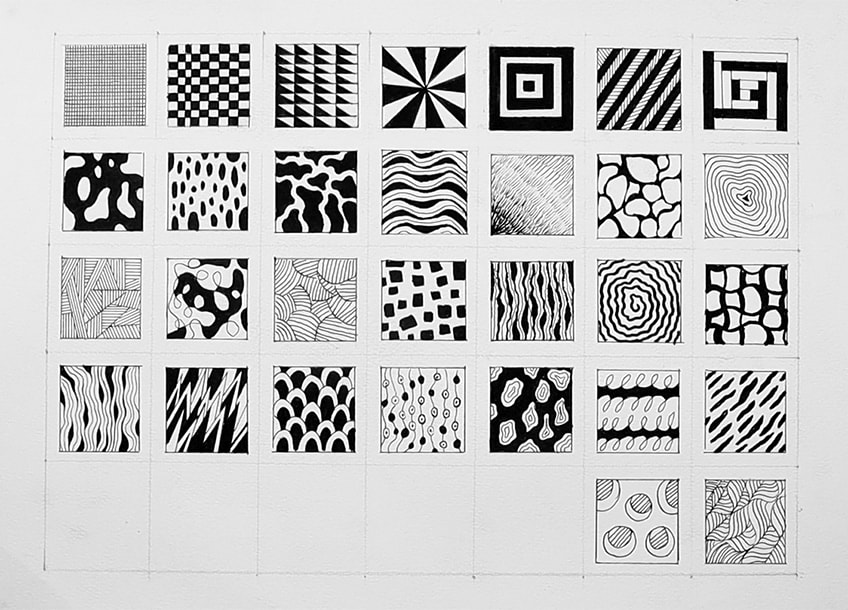
You then can simply fill in the space around the circle with your marker. You can also try to do this pattern in an inverse way if you’d prefer.
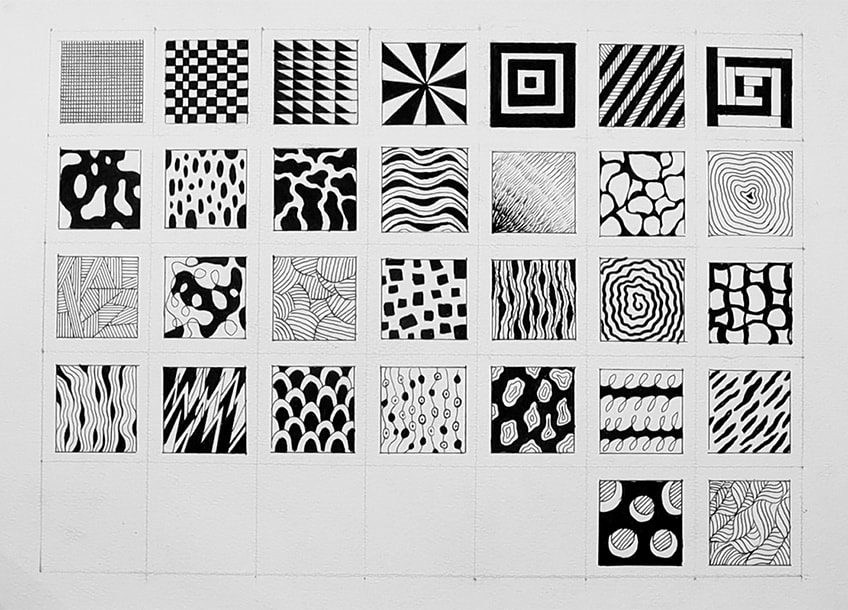
Retro Square Pattern
Here is another retro-inspired pattern. We draw this pattern by drawing a set of overlapping squares with soft curved edges.

We then can color all the small overlapping sections to create a strange effect within the squares. From there, you can add lines into the remaining open spaces for a more creative effect.
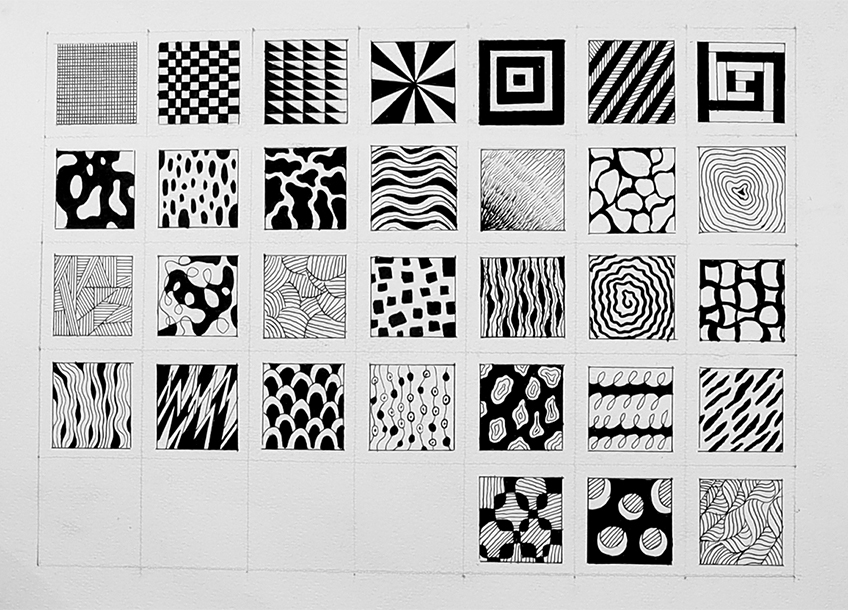
Criss-Cross Tiles Pattern
This pattern has a very classy effect and can work well in various design-related practices. We start by making a simple, evenly-spaced grid by drawing a set of vertical and horizontal lines.

We then proceed to work row by row, as we fill in each block with a set of parallel horizontal lines and then the next with parallel vertical lines. You can do this row by row so that you don’t make the mistake of pairing the same tiles together.
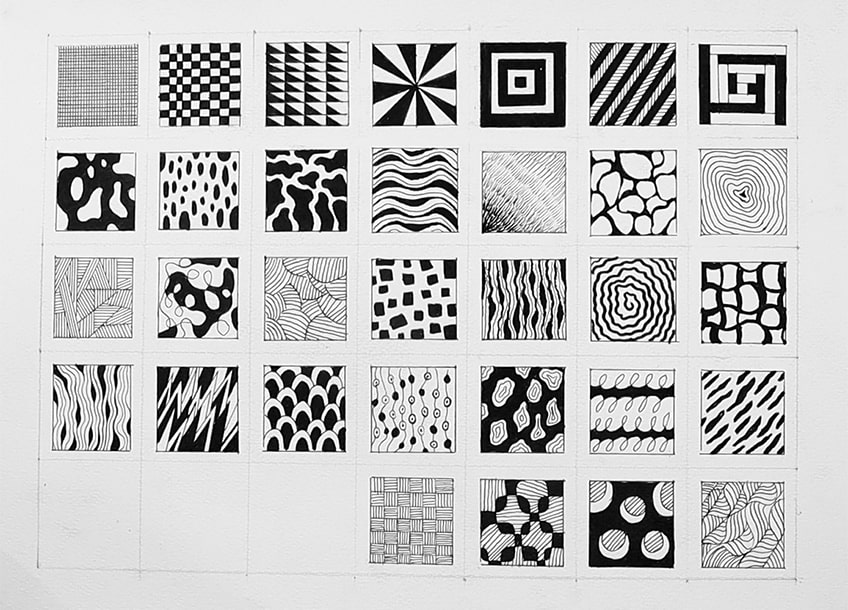
Skyline Pattern
This really easy-to-draw pattern is quite strange because, when flipped around, it has the same quality but in inverse. We draw this pattern by simply constructing different-leveled geometric bars. We then can fill in one side completely and create a unique distinction between black and white.
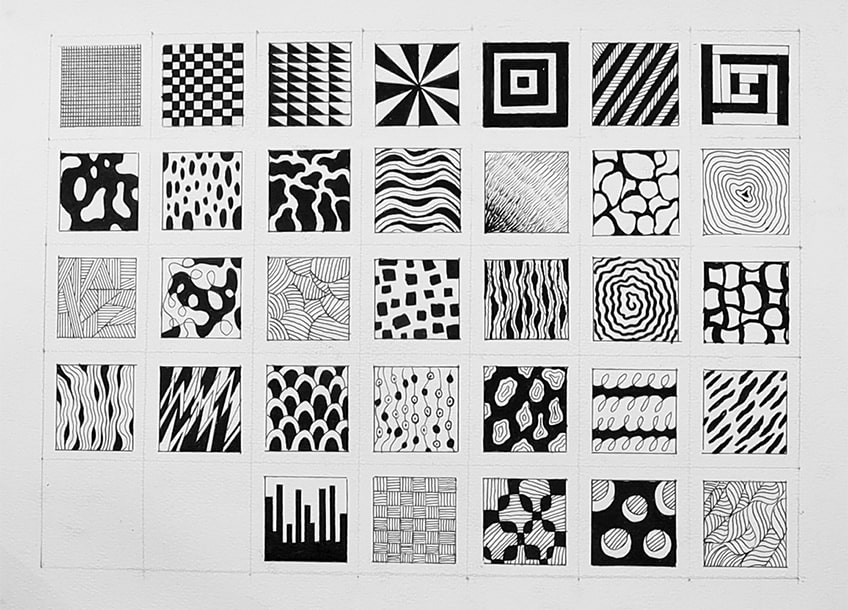
Abstract Bats Pattern
This basic pattern design is a more comic-inspired design that can be integrated into more pop-culture-inspired designs. We draw this pattern by creating a set of M-shaped bats. We then can draw a border around them and fill in the block surrounding the borders.
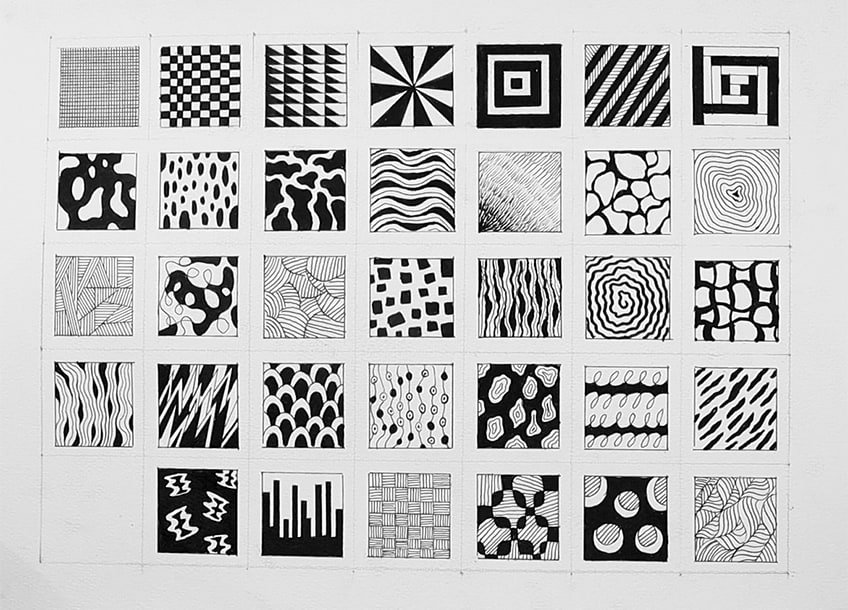
Curved Polka-Dot Pattern
Lastly, to finish off, a simpler curved polka-dot pattern that is very versatile and can be used in various ways. We draw this pattern by creating a set of basic curved polka dots. We can also play around with length and orientation to give it a more motion-like aesthetic.

And those were 35 unique easy patterns to draw. Now you know a bunch of simple basic patterns that you can draw with a marker, a pen, and a ruler. Experiment and play around with these patterns, and try to be creative about how you can integrate them into your own practice.
Tips to Remember
- Take your time. Don’t rush through each pattern.
- Consider different aesthetics between organic and geometric patterns. For your own pattern drawings, consider nature and industrial environments for inspiration.
- Use your ruler as a tool. A ruler is a great way to measure and keep lines straight for certain pattern design ideas.
- Feel free to deviate from any of the designs. You can tweak any of these patterns to make different variations.
- Incorporate them into your artwork. Experiment with how you can use these different basic patterns in your own work.
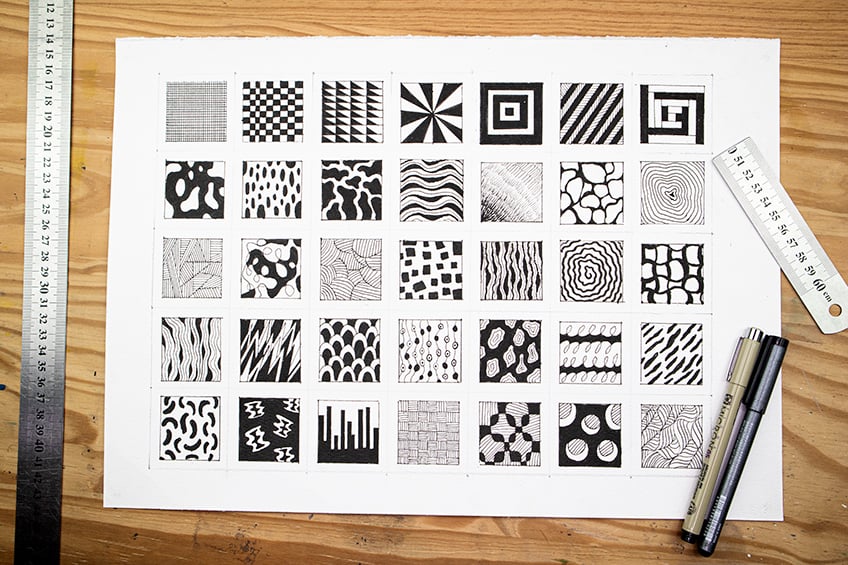
This tutorial gives you a great base of easy patterns to draw ideas for drawing that you can adapt and change in your own way as you choose. These patterns provide you with a good foundation for problem-solving and how to think about your own pattern ideas. Always consider drawing inspiration from your surrounding environment when exploring basic patterns.
Take a look at our simple patterns webstory here!
Frequently Asked Questions
What Can Pattern Designs Be Used For?
Pattern ideas for drawing are endless, and their applications are so versatile. In many ways, patterns can be incorporated into realistic drawings, such as a potential fabric design on a dress of a character. Patterns can also be artworks themselves, as they can often have an abstract aesthetic that can stand on its own. Various pattern design ideas can also be interchangeable between traditional artwork practices and other design-related practices. Exploring pattern ideas for drawing is also a great way to destress and occupy your mind. As an artistic intervention, design concept, or a self-soothing activity, exploring basic patterns and drawing them is a great mental and creative exercise.
Can You Use Patterns for Abstract Drawings?
Patterns are in themselves abstract and often are only contextualized when incorporated within creative realms. This means that they can be the aesthetic for garments, materials, backgrounds, and for various other creative reasons. However, perhaps the most fun way to use patterns is to create abstract and strange artworks that are made up solely of patterns. There are so many ways to use patterns to create strange and interesting abstract artworks. Experimenting with incorporating various pattern design ideas in a single artwork can be a great way of creating an abstract artwork that can be interesting and visually beautiful.
Matthew Matthysen is an educated multidisciplinary artist and illustrator. He successfully completed his art degree at the University of Witwatersrand in South Africa, majoring in art history and contemporary drawing. The focus of his thesis was to explore the philosophical implications of the macro and micro-universe on the human experience. Matthew uses diverse media, such as written and hands-on components, to explore various approaches that are on the border between philosophy and science.
Matthew organized various exhibitions before and during his years as a student and is still passionate about doing so today. He currently works as a freelance artist and writer in various fields. He also has a permanent position at a renowned online gallery (ArtGazette) where he produces various works on commission. As a freelance artist, he creates several series and successfully sells them to galleries and collectors. He loves to use his work and skills in various fields of interest.
Matthew has been creating drawing and painting tutorials since the relaunch in 2020. Through his involvement with artincontext.org, he has been able to deepen his knowledge of various painting mediums. For example, watercolor techniques, calligraphy and lately digital drawing, which is becoming more and more popular.
Learn more about Matthew Matthysen and the Art in Context Team.








